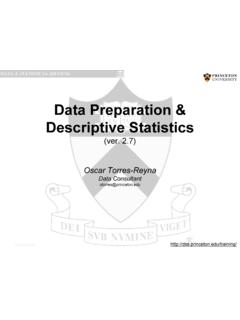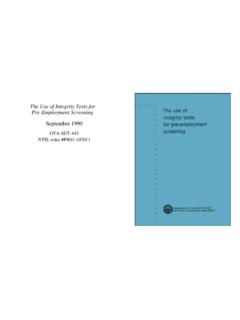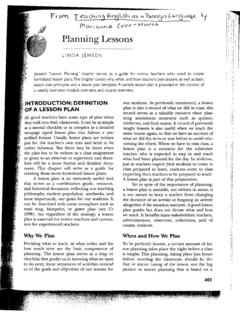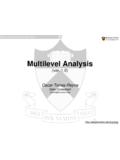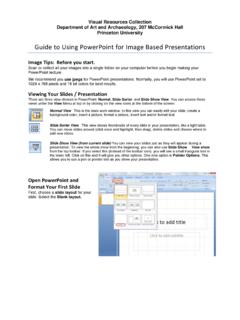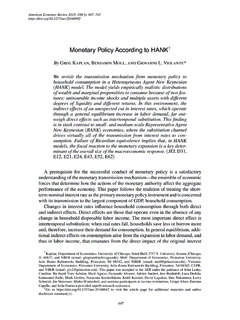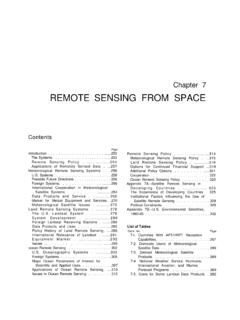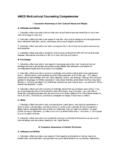Transcription of Economic and Political Influences on Immigration Policy ...
1 The Economic and Political Influences on Different Dimensions of United States Immigration Policy Helen V. Milner Dustin Tingley Word Count: 9963 (including footnotes and references). Abstract Recent research on Political attitudes towards Immigration often pits arguments emphasizing Economic self-interest against ideological or cultural explanations. Many of these studies conceptualize Immigration Policy along a single dimension instead of disaggregating it into its distinct Policy dimensions. Conditional on the type of Immigration Policy , different explanations should have more or less explanatory power. We disaggregate Immigration Policy into six different dimensions and provide theoretical scope conditions for when ideological and Economic factors should matter.
2 We test these predictions on votes on Immigration Policy in the US House of Representatives from 1979-2006. We advance the debate on the determinants of Immigration Policy by showing that both Economic self-interest and ideological explanations can be powerful, depending upon the type of Immigration Policy under consideration. 1. Section I: Introduction With globalization resulting in the increased movement of people around the globe, Immigration has become a significant Political issue in most developed countries. In the United States and Europe, Immigration Policy has been at the center of large public demonstrations and sustained Political debate.
3 As a result, the politics of Immigration Policy need to be better understood. By its nature, Immigration Policy is multidimensional, and hence the supporters and opponents of different types of Immigration Policy will vary. 1. Asking who supports and who opposes Immigration overlooks the fact that some individuals will have incentives to support some types of Immigration policies but not others. Unfortunately much of the literature appears to miss this, in part because public opinion research often is based on generic questions about increasing or decreasing levels of Immigration . Actual Immigration Policy is differentiated not only by the type of immigrant affected, but also by the types of instruments ( , border control, visas) used to manage immigrants.
4 For example, a recent literature focuses on the public finance dimension of Immigration , but not all Policy decisions about immigrants involve fiscal issues. Indeed recently, the politics of Immigration have increasingly centered on border security. From our study spanning 27 years of votes in the US House of Representatives, we provide clearer tests of Economic and ideological theories by studying the varying influence of these factors on different types of Immigration Policy votes. Immigration Policy includes many distinct issues; here, we consider six main types of Immigration legislation, which we think captures most legislation on the issue.
5 The six types are: 1. Eytan Meyers (2000), for instance, breaks Policy into categories about immigrant entry and ones about resident immigrants, but focuses his attention only on the entry dimension. 2. high-skill employment visas, low-skill employment visas, welfare benefits for immigrants, employer constraints, border security, and final passage of over-arching Immigration reform. Recent debates about Immigration Policy focus on the relative impact of Economic self- interest and ideological or cultural factors (Burns and Gimpel, 2000; Citrin et al., 1997; Facchini and Mayda, 2009; Facchini et al., 2009; Hainmueller and Hiscox, 2007, 2010; Luedtke, 2005.)
6 Mayda, 2006). In terms of theories of Economic self-interest, the state of the art in Immigration literature presents an interactive model where concerns about an individual's Economic gains or losses from Immigration are conditioned by the fiscal impact of Immigration Policy (Borjas, 1999a, b; Facchini and Mayda, 2009). Earlier research claimed that an individual's relative capital and labor endowments influenced his or her attitudes toward Immigration because of the labor market ramifications of Immigration , its effect on wages and employment (Fetzer, 2006; Gonzalez and Kamdar, 2000; Scheve and Slaughter, 2001a).
7 Individuals with high levels of skill stand to gain from low-skill Immigration , and thus should be its major supporters. However, the public finance perspective points out that in environments with high levels of redistribution, these same high-skill individuals will have to pay for low-skill immigrants, who use social services more intensively than do high-skill (and hence wealthy) citizens. Hence the labor market effects of Immigration on Policy preferences may be moderated (Facchini and Mayda, 2009; Hanson et al., 2007). Because of the size of the welfare state in many developed countries with rising Immigration , the fiscal consequences of allowing poorer individuals into social systems with well-established safety nets have become a vibrant Political issue (Gimpel and Edwards, 1999).
8 Others find less support for the role of public finance, or Economic variables in general, and instead stress ideological and cultural factors (Citrin et al., 1997;. Hainmueller and Hiscox, 2010). In this paper we focus on both Economic self-interest . 3. especially the interactive model of labor markets and public finance and ideological factors that might affect attitudes about Immigration Policy . We expect and show that the influence of the two sets of factors depends a great deal on the type of Immigration Policy under consideration. The influence of public finance variables depends on whether the vote involves issues that have direct public finance consequences.
9 We argue, and find, that public finance variables will be most salient for votes on visas for low-skill immigrants and social benefits for immigrants. In this way, we extend existing research on public opinion to the legislative arena as well as provide a richer perspective on Immigration Policy than do analyses that aggregate all types of policies or focus on shorter periods of time (Facchini and Mayda, 2009; Hanson et al., 2007). 2. Our overall contributions to the literature are threefold. First, we highlight how widely the substantive content of legislation that is called Immigration Policy varies and thus point out the risk of obscuring important differences across policies if the analysis does not disaggregate the legislation.
10 We show that different factors affect attitudes toward different Policy dimensions. Hence we help adjudicate the important debate over Economic versus ideological factors as Influences on Immigration Policy . Second, we provide a critical test of public finance theory in the legislative setting. Hence as in the trade literature, which has examined both public opinion and legislative voting, our extension of public finance arguments helps provide a more 2. To date, scholars have either included all available votes on a particular legislative bill (Medina, 2007), analyzed a single final passage vote (Fetzer, 2006; Gonzalez and Kamdar, 2000.)
